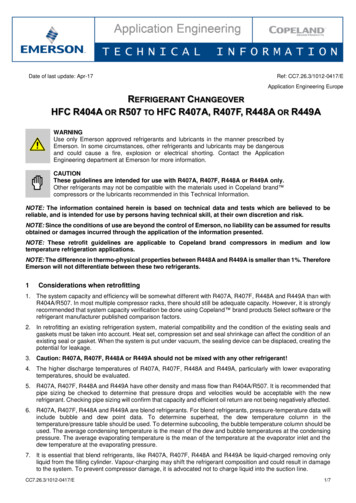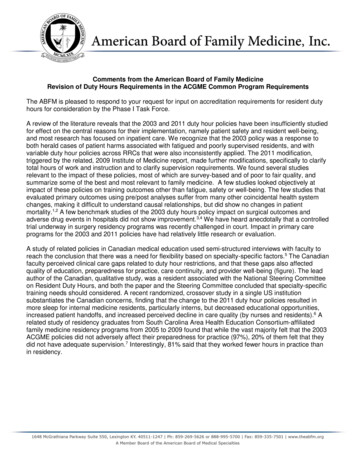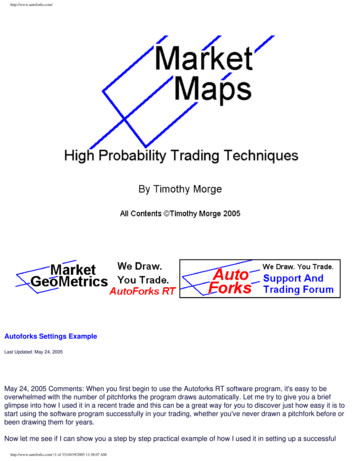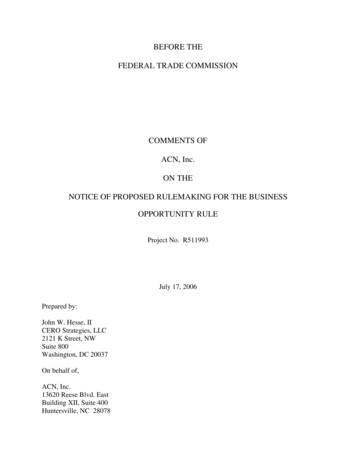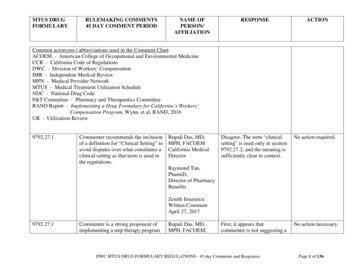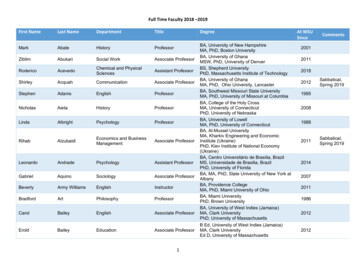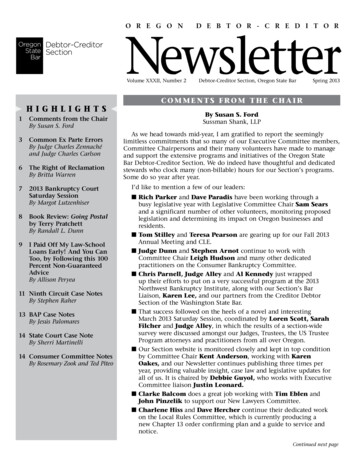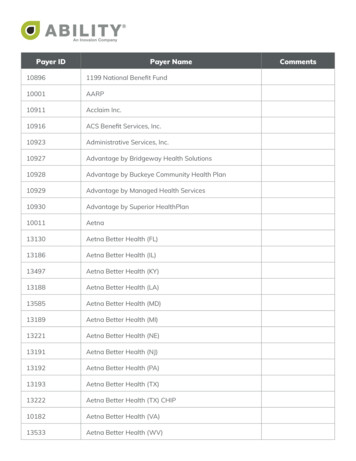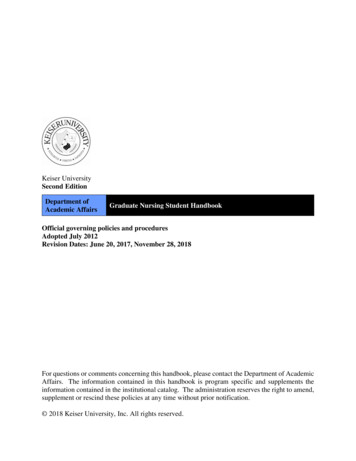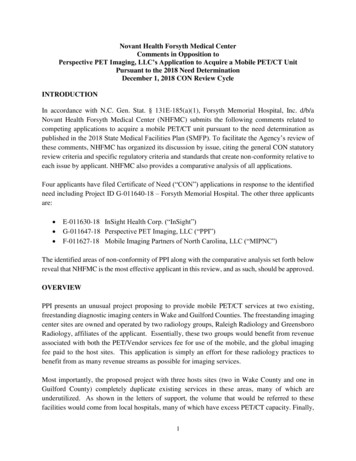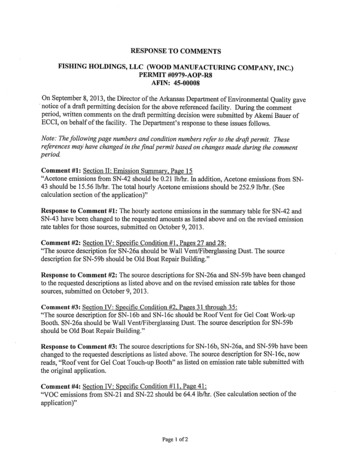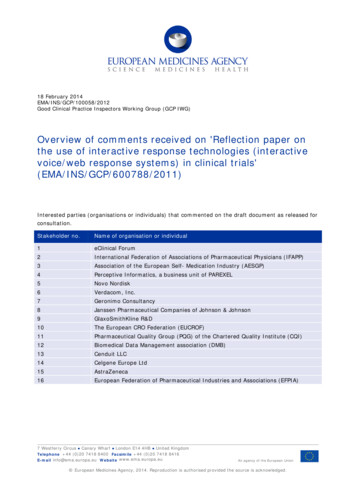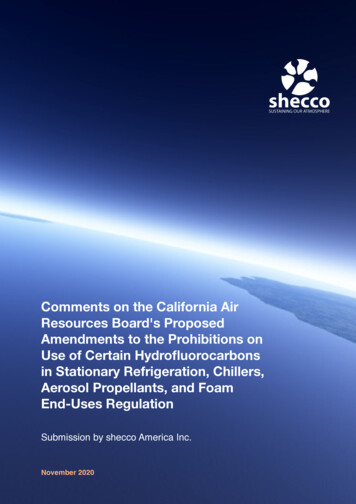
Transcription
Comments on the California AirResources Board's ProposedAmendments to the Prohibitions onUse of Certain Hydrofluorocarbonsin Stationary Refrigeration, Chillers,Aerosol Propellants, and FoamEnd-Uses RegulationSubmission by shecco America Inc.November 20201
shecco America Inc. welcomes this opportunity to comment on the ProposedAmendments to California’s HFC Regulation. We are a market accelerator for climatefriendly refrigeration and air conditioning technologies with a global presence.Together with our network of industry-leading partners, we are global experts inalternatives to HFCs with nearly 20 years active in the Heating, Ventilation, AirConditioning and Refrigeration (HVAC&R) industry. More specifically, we concentrateon accelerating the uptake of natural-refrigerant-based technologies such as carbondioxide, ammonia, hydrocarbons, air, and water.We believe in setting ambitious targets for the elimination of HFCs in the HVAC&Rmarket, which can be supported by proven, commercially available, U.S.manufactured natural-refrigerant-based technology already on the market today.However, we believe incentives and subsidies are necessary to support the transitionto more climate-neutral, low-Global Warming Potential (GWP) solutions.Natural-refrigerant-based air-conditioning and refrigeration equipment has beendeployed in the U.S. for many years - in particular ammonia-based systems, andincreasingly CO2 and hydrocarbon solutions as well. These systems and associatedcomponents are predominantly manufactured locally in the U.S., employing thousandsof American citizens with huge potential to scale up as policy and incentives drives themarket towards more environmentally sustainable, natural HVAC&R solutions.It is encouraging to see that the U.S. manufacturers of natural-refrigerant-basedproducts are keeping up with global trends and technology - often even setting the barfor the rest of the world. Market research conducted by shecco in 2019/2020 indicatesthere are more than 650 stores in the U.S. already using CO₂ transcritical technology,as well as over 530 low-charge ammonia installations in mostly industrial facilities. Thisis the most cutting-edge technology on the market today and the total number ofnatural-refrigerant-based systems on the continent, is in the 1,000s.There is great potential for this booming sector to stimulate growth in the U.S.economy. A strong legislative framework that favors HFC-free equipment, togetherwith incentives and subsidies to support HFC-alternative solutions, would allowAmerican companies to also export their products and know-how internationally to beglobal industry leaders in this field.2
On the AmendmentsIn our experience, HFC bans for placing on the market new HVAC&R equipment is themost effective measure to deliver emission reductions and meet climate targets.Sectoral bans give clarity to industry to move away from HFCs within a clear timeline –rewarding the innovators, whilst also allowing sufficient time for those that are laggingbehind to change their technology focus. We believe that climate policy, and resultingHFC bans, should be as ambitious as possible to accelerate the transition to climatefriendly alternatives.Please see below our comments on the specific amendments proposed:“New refrigeration systems containing more than 50 pounds ofrefrigerant and used in newly constructed and fully remodeled facilitieswill be required to contain refrigerants with a global warming potential(GWP) less than 150, effective January 1, 2022. This includes thefollowing end-uses: retail food refrigeration, industrial processrefrigeration (IPR) (except chillers), cold storage, and ice rinks.”Position Summary1. We support the 2022 timeline.2. This ban aligns with the HFC phase down and avoids the use ofclimate-damaging intermediary solutions.3. Natural-refrigerant technology is already widely used across the U.S.and can support this sector. We support the 2022 timeline because the industry has alreadydeveloped a variety of market-ready, commercially available HFC-freetechnologies that have proven to be energy efficient and cost effectivein the U.S. and beyond - there are hundreds of examples of successfulinstallations in the U.S across the HVAC&R sector (some which we willshowcase in this comment). Such a ban would also be very well aligned with the Montreal ProtocolHFC phase-down schedule, giving the industry clear direction to adoptvery low-GWP, HFC-alternative technologies such as naturalrefrigerants and avoid intermediary solutions that might cause long-termclimate damage.3
Industrial Refrigeration Market DataTraditionally dominated by ammonia and HFCs, theuse of CO₂ transcritical systems has increasedsignificantly in industrial refrigeration. In the U.S today,7% of all transcritical CO₂ systems are for industrialsites (see Figure 1).Figure 1Key drivers for uptake are mainly the increased safetyCO₂ offers, as well as higher energy efficiency, easierservicing, better return on investment for the end user,and the cost reduction of technology thanks to thegrowing competition and demand.Low-charge ammonia has also been gainingmomentum in the U.S., with an estimated 530installations (Figure 2).Hydrocarbons are also available and used for specificindustrial applications. For instance, a cold storagewarehouse for post-harvest flower processing andexport in Colombia is using hydrocarbon R290 with thesupport of the United Nations Ozone Unit.1The growing competition between natural refrigerantswill likely push innovation to increase performance,and ultimately reduce costs.American companies are embracing naturalrefrigerants for industrial refrigeration and realizinggreat emission and energy savings: Source: shecco (2020), World Guideto Transcritical CO2 deBimbo Bakeries is commissioning its first natural refrigeration equipment – anammonia/CO2/glycol system – in one of its fresh bakeries in Chicago. Thesite was using a direct expansion (DX) system, which were prone to leak intothe baking operation. The system had been converted from R22 to R422B,but it continued to leak. It is expected to use up to 440MWh less energy peryear than conventional systems, cutting 460 metric tons of CO2e emissions.Based on current prices, this amounts to a US 30,000 saving each year.2Argentine Retailer La Anónima Commits to Transcritical CO2, https://www.r744.com/articles/9802/argentine retailer la anandoacute nima commits to transcritical CO₂1Bimbo Bakeries USA Installs First NatRef System for Fresh Bakeries, http://www.ammonia21.com/articles/9801/bimbo bakeries usa installs first natref system for fresh bakeries24
Figure 2Source: shecco (2019), World Guide to Low-Charge Ammonia https://issuu.com/shecco/docs/a21 report final5
“Companies owning existing systems containing more than 50 pounds ofrefrigerant in retail food facilities will be required to meet a GWP-BasedCompany-wide standard – either through a reduction in their company-wideweighted-average GWP to less than 1,400 GWP by 2030, or, in thealternative, reduce their Greenhouse Gas Emission Potential or GHGp by 55percent by 2030. All non-retail food facilities installing new systems mustmeet the GWP limit of less than 1,500 or 2,200, depending on the end use.”Position Summary1. Refrigeration systems using HFC-alternative refrigerants are alreadysupported by many large U.S. manufacturers and end-users.2. U.S. manufacturers are installing more and more natural-refrigerantbased systems each year.3. Bans should set the pace for advancing technology. shecco America Inc. recommends accelerating the ban to avoid furtherdelays in technology transition. We believe that a 2030 timeline is notambitious enough and this could be brought forward. We also believe that the GWP limit for new systems should be furtherreduced. The use of natural-refrigerant-based solutions in this sector is growingin the U.S. with the number of systems successfully manufactured andinstalled growing rapidly. The use of natural refrigerants is advantageous in that it contributes tolowering emissions, which helps companies to achieve corporatesustainability report objectives. Firstly, companies are able to cut emissions by replacing fluorinatedgases with refrigerants such as isobutane (R600a), R290 and CO₂(R744) which have zero ozone depleting potential (ODP) and anegligible global warming potential (GWP). Secondly, these refrigerantscan be more energy efficient than traditional fluorinated refrigerants.6
Commercial Refrigeration Market DataFigure 3Source: shecco (2020), World Guide to Transcritical CO2 Refrigeration https://issuu.com/shecco/docs/r744-guideIn the sector of supermarket refrigeration (commercial refrigeration), the use of state-ofthe-art transcritical CO₂ refrigeration is becoming the “standard” rather than the“alternative” technology in many countries, as can be seen in the map in Figure 3. Eventhe U.S had 650 confirmed transcritical CO₂ installations by June 2020.As the standard CO₂ transcritical technology for supermarkets has matured, the focusof technological innovation has shifted to the development of optimal solutions for smallformat stores and warmer ambient climates.3In the U.S, transcritical CO₂ installations have almost doubled since 2018 as seen inthe table in Figure 4. While the United States may be behind in terms of the totalnumber of transcritical stores, they are at the forefront of technological advancementswith innovative CO₂ installations in warm-ambient climates.New transcritical installations have been eliminating long-held beliefs about thetechnology's climate limitations in relation to energy efficiency. As an example:3https://issuu.com/shecco/docs/f-gas impact shecco october20167
Kysor Warren Epta U.S. has started installing transcritical CO₂ (R744)systems incorporating FTE (Full Transcritical Efficiency) technology in theU.S. All five systems are in new stores. Four of the five stores are located inAlabama, Georgia and South Carolina, which have a hot/humid climate, withambient temperatures up to 40 C/104 F. The other is located in Tennessee, amoderate climate.4 U.S. OEM Hillphoenix, Conyers, Georgia (U.S.) provided a system for a75,000ft² (6,968m²) Seed to Table Market, a refurbished Albertsons store thatopened in December 2019 in North Naples, Florida, the most southeasternstate in the U.S. The system includes three rooftop adiabatic gas coolersfrom Baltimore Aircoil (BAC), which helps the system function efficiently inthe balmy climate of southwest Florida.5Figure 4Source: shecco (2020), World Guide to Transcritical CO2 Refrigeration https://issuu.com/shecco/docs/r744-guideKysor Warren Epta U.S. to Have Five FTE Transcritical Installations, http://www.r744.com/articles/9835/kysor warren epta u s to have five fte transcritical installations in 20204Transcritical CO2 in Warm, Muggy Florida, anscritical-co2-in-warm-muggyflorida-2/2020/58
Light Commercial Refrigeration Market DataThrough the innovation and dedication of large consumer brands, vending machines,ice cream freezers, bottle coolers and refrigerated cabinets all around the world areincreasingly cooled by CO₂ and hydrocarbons.In some cases, natural refrigerants can register savings of up to 33% in energy use inlight commercial refrigeration equipment.6There are more than 5.5 million HFC-free light commercial units (both HCs and CO₂)collectively put in the market already by leading consumer brands – Coca ColaCompany, PepsiCo, RedBull and Unilever – which have joined the initiative"Refrigerants, Naturally!”.7 In addition, an increasing number of other consumer brandsare choosing hydrocarbons for their point-of-sale equipment (bottle coolers, vendingmachines, ice cream freezers), often targeting global 100% procurement.6GUIDE to Natural Refrigerants in Japan - State of the Industry 2016, https://issuu.com/shecco/docs/guide japan-20167Accelerate Australia & NZ #8, America’s Pledge includes HFC reduction, https://issuu.com/shecco/docs/1801 aaunz/559
“New air conditioning (AC) equipment used for both residential andnon-residential purposes must use refrigerants with a GWP less than750, effective January 1, 2023.”Position Summary1. The 750 GWP should be lowered to 150 as suitable technologyalready exists to support this.2. A GWP of 750 would lead to an influx of climate-damagingintermediary solutions.3. Incentives are needed to support this transition and spur localmanufacturing and innovation. It is our belief that the HVAC&R industry is both willing and able totransition to more climate-friendly alternative solutions within the airconditioning (AC) sub-sector. This would be a welcome transition, giventhe high percentage of the market that the AC sub-sector occupies.However, we do have to express our concern that, without subsidiesand incentives, a transition by 2023 would be too ambitious. Furthermore, we believe that a GWP of 150 would be a moremeaningful goal than 750, as suitable technology with this much lowerGWP already exist and would avoid an unnecessary intermediary step. Many believe that the solution for AC lies in R32, however we cautionagainst its use. Promoted as a “low-GWP” solution, R32’s GWPmeasured over 100 years (GWP100) is only 675. However, this gas stayspotent in the atmosphere for about 21.7 years and when its GWP ismeasured over 20 years (GWP20) instead, it was found to be 2,330.8 Bypresenting GWP100 data instead of more accurate GWP20 data, this ismisleading the public as well as policymakers in terms of whichrefrigerants are actually climate friendly and sustainable. Solutions for natural-refrigerant-based AC already exist - both within theresidential as well as the non-residential sectors. shecco held atechnical conference this summer on AC using natural refrigerantswhere numerous successful case studies on the matter were presented.All the information can be found here. Incentives are essential to accelerate the adoption of natural refrigerantbased technology. From the end-user perspective, especially for smallKanter, D., Mate, J. 2012. The Benefits of Basing Short Term Climate Protection Policies on the 20 Year GWP of HFCs. Frankfurt,Öko-Recherche GmbH.810
and medium-sized businesses and individuals, the ‘price tag’ is oftenthe decisive factor when purchasing new equipment. Subsidies canalleviate the barriers and provide support while maximizing ozone andclimate benefits. Subsidies would also accelerate economies of scale,which would have impact on reduction of cost for such technology overa certain period of time. Furthermore, they are a useful tool to spur localmanufacturing and lead the way in new technology. Opting for more ambitious targets would spur innovation, give boost tofront-runners and ensure California is well ahead with thedevelopments, as the whole world will be looking for HFC alternativesolutions ahead of the global HFC phase-down.Air-conditioning Market DataIn China and India, 20 production lines have already been converted to manufacturingR290 split ACs. “The conversion of existing conventional production lines for R22 orR410A technology can be realized with relatively little investment.” Manufacturers whohave already transformed their production lines include: Midea, Haier, TCL, Gree,Hisense, Changhong, AUX, and Yair.9India is also showing a growing interest in R290 RAC, with more than 650,000 unitscurrently installed in the market.10According to shecco’s estimates from data collected, more than 300,000 portablehydrocarbon AC units have been sold in Europe.11Some examples of existing natural-refrigerant-based, commercially available HVACtechnology: Polaris manufacturers a HideAway series of ducted packaged airconditioning units that do not require a separate outdoor unit; as well as itsIntelligent Series of split systems with inverter technology. These employM60, a hydrocarbon refrigerant blend. The highly efficient reverse-cyclePolaris systems are expected to cut energy consumption in excess of 65%compared to the old R22 systems it replaces. The new systems use only1.2lbs of M60 per HideAway unit, and 4.2lbs per Intelligent Series unit.12 Climate Wizard indirect evaporative cooler runs completely on water(R718) and is made by Australian manufacturer Seeley International. TheClimate Wizard can operate in ambient temperatures up to 131 F (55 C) withGIZ, R290 Split Air Conditioners Resource Guide, ileadmin/Dokumente/2019/R290 SplitAC ResourceGuide Proklima.pdf9GIZ, R290 Split Air Conditioners Resource Guide, ileadmin/Dokumente/2019/R290 SplitAC ResourceGuide Proklima.pdf1011LIFEFRONT Report, Impact of standards on hydrocarbon refrigerants in Europe, https://issuu.com/shecco/docs/impact of standards om hydrocarbonAustralian Building Replaces R22 ACs with Hydrocarbon Units, 11
an increase in performance the warmer it becomes. It uses a patentedcounterflow heat exchanger that allows supply temperatures to be deliveredat 1.8-5.4 F (-16.78 C to -14.78 C) below the ambient wet bulb temperature.Where Climate Wizard is being used in lieu of a chiller plant, Seeleyestimates that the energy saving will be approximately 80% while the peakelectrical demand for the site was reduced by 60%.1313Evaporating Water for AC, ating-water-for-ac/2020/12
For more information, please contact:Marc ChasserotCEO, shecco America Inc.marc.chasserot@shecco.comTel : 1 917 724 7813Ilana KoegelenbergMarket Development Manager, sheccoilana.koegelenberg@shecco.comCell: 32 471 78 58 3413
“New air conditioning (AC) equipment used for both residential and non-residential purposes must use refrigerants with a GWP less than 750, effective January 1, 2023.” It is our belief that the HVAC&R industry is both willing and able to transition to more climate-friend
